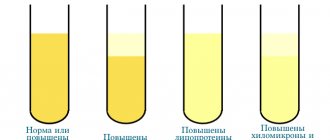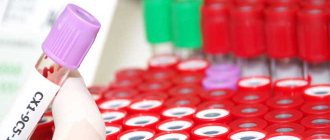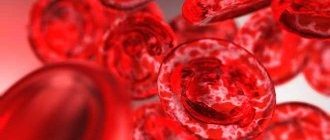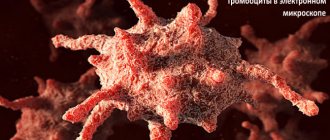General blood tests
02/10/201801/24/2019 Chernenko A. L. 2246 Views biochemistry, cholesterol
Despite the widespread belief that cholesterol is harmful, it is a vital substance in the human body. Cholesterol acts as a substrate for the synthesis of steroid hormones, participates in the stabilization of cell membranes, promotes adequate myelination of nerve fibers, participates in metabolism, etc.
Cholesterol is insoluble in liquid, so it is transported in the body as part of lipoprotein complexes. Depending on the density and size of the particles, they are divided into:
- High-density lipoproteins (HDL) are representatives of the “good” cholesterol fractions. They help normalize and maintain the elasticity of vascular walls, reduce blood viscosity and reduce the risk of developing atherosclerotic vascular lesions);
- low-density and very low-density lipoproteins (representatives of the so-called bad cholesterol, which increases the risk of developing severe atherosclerotic vascular damage and, as a consequence, the development of cardiovascular diseases).
A blood test for cholesterol allows you to timely detect imbalances between lipid fractions, and therefore reduce the risk of developing heart attacks and strokes. Standard lipid profile tests include total cholesterol levels and blood tests for HDL, LDL and VLDL.
- 1 What is HDL in a biochemical blood test? 1.1 Indications for testing for CAP lipoproteins
- 1.2 How to prepare for the test?
HDL (HDL) - what is it in a biochemical blood test?
HDL / HDL (or High-Density Lipoproteins) are micro/particles in the blood plasma (8-11 nm in size), mainly consisting of proteins and lipids (fats). Their main function is to “transport” excess cholesterol from peripheral tissues to the liver (through the bloodstream) for “utilization” (and removal from the body through the gastrointestinal tract).
HDL structure: apolipoproteins A1 (67%), proteins (45-55%), phospholipids (27-30%), triglycerides (3-7%), cholesterol (17-22%). Initially (after creation in the liver) it takes the form of a disk, as indicated in the topmost image.
That is why HDL cholesterol is usually called “good” cholesterol, because High-density lipoproteins (being the densest, smallest and fastest particles in the blood) have anti-atherogenic properties, taking away excess – conditionally “bad” cholesterol, i.e. LDL cholesterol (Low Density Lipoprotein).
The latter, in fact, is also useful for our lives, dangerous - an EXCESS of it!
High levels of “bad” cholesterol are usually associated with increased risks of developing atherosclerosis
and a number of cardiovascular diseases.
Penetrating into the walls of blood vessels ( SEE VIDEO AT THE BOTTOM OF THE PAGE - 43 sec
), micro/particles of LDL can be deposited there (over and over again), thereby forming “slides”, which are commonly called “cholesterol plaques”. Over time, the “slides” become higher and larger, blocking the gaps in the vessels. Up to complete blockage (obturation). And this is fraught with a heart attack, stroke or gangrene (of the limbs).
Additional Information
The main problem in interpreting the results of studies on HDL is that it is difficult to determine how much of a role other factors play. For example, if there is an association between young men who eat a low-fat diet and also have high HDL cholesterol, it is also possible that the same men do not smoke and exercise regularly. Additionally, many of these studies are self-report and participants do not always answer truthfully. []
It is generally assumed that increasing dietary cholesterol intake will also increase blood cholesterol levels and, over time, lead to heart disease. While this is partially true, it is important to note that only 25% of blood cholesterol comes from food. The remaining 75% of cholesterol in the blood is synthesized by the body, and this is largely controlled by genetics. []
The information on this site has not been evaluated by any medical organization. We do not seek to diagnose or treat any disease. The information on the site is provided for educational purposes only. You should consult your physician before acting on information from this site, especially if you are pregnant, nursing, taking medications, or have any medical condition.
Rate this article
Average 5 Total votes (6)
When is it necessary to know the amount of HDL in the blood?
As a rule, the level of high-density lipoprotein (HDL) in the blood plasma is determined using a LIPIDOGRAM
.
That is, a special biochemical (complex) blood test that helps identify virtually all unhealthy lipid levels, which is very important for doctors to know - to assess the risks of developing cardiovascular diseases (CVD), and prescribe adequate treatment to the patient. At the same time, depending on what these levels are: borderline or already dangerous (for WOMEN
and
MEN
separately / by age)?
Other components of the lipid profile (except HDL cholesterol) are: total cholesterol (or total cholesterol), LDL cholesterol (low density lipoproteins) and TRIGLYCERIDES (TG)
.
As mentioned above, it is HDL cholesterol that is useful and good, because it removes excess conditional / “bad” cholesterol in the blood, “transporting” it back to the liver. Consequently, an insufficient amount of it in the blood plasma is fraught with negative consequences, and normalization (on the contrary) leads to recovery. That is why doctors prescribe such tests - both to identify the problem and to monitor the effectiveness of treatment (with a special diet, a health-improving set of physical exercises, or taking lipid-lowering medications).
In the future, the medical professional may need to separately - only the values of total cholesterol (TC) and good (i.e. HDL cholesterol / HDL-C). Necessary for calculating the COEFFICIENT (INDEX) OF ATHEROGENICITY
(by the way, it can be calculated
ONLINE
on our website). But first you will always be prescribed a comprehensive blood test (i.e., full lipid spectrum). Especially if the history reveals so-called risk factors (according to the recommendations of the NCEP / National Cholesterol Education Program committee of 2002). The most important of which (for adult men and women) will usually include:
- nicotine addiction (or even “indulgence” in smoking);
- obesity (or overweight problems / with a BMI over 25
/
ONLINE BMI CALCULATOR
); - unhealthy (harmful/fatty) diet;
- physical inactivity (little/active lifestyle, possibly due to “sedentary” work);
- age limits (men are over 45 years old, and women are over 55 years old);
- hypertension (high blood pressure - from 140/90 mm Hg and above);
- family history of premature CVD (that is, cardiovascular disease in close “blood” relatives: men under the age of 55 years, women under the age of 65);
- the presence of cardiovascular disease syndromes, as well as a previous heart attack;
- diabetes or pre/diabetes.
For teenagers and children
A comprehensive blood test that determines fat/lipid levels is necessary not only for adults, but also for children. According to the recommendations of the American Academy of Pediatrics, children should be tested for preventive purposes: the first time - between the ages of 9 and 11 years, and again - between the ages of 17 and 21 years.
As is the case with adults (or the elderly), children or adolescents (especially if there are risk factors) may also need additional blood testing (i.e., more frequent testing). The most important risk factors include: a family history of CVD (cardiovascular disease), and if their blood relatives suffer from diabetes, hypertension and obesity.
In addition, medical professionals can prescribe a lipid profile even for a child under the age of 9 if his parents have problems with high cholesterol levels. However, a lipid profile is never prescribed for children under 2 years of age!
For monitoring purposes (observation of treatment)
A blood test to determine the level of HDL “good” cholesterol can be prescribed by doctors - regularly, i.e. at certain intervals. And, first of all, this is necessary to assess the effectiveness of certain lifestyle changes, such as a “low-fat” diet, a set of physical exercises and, of course, a complete cessation of smoking. According to the recommendations of foreign experts (“American College of Cardiology” / “American Heart Association”), adults taking statins must undergo a lipid profile (on an empty stomach) 4-12 weeks after starting to take medications. And then - every 3-12 months, because... Healthcare professionals should make sure these medications are working properly.
Structure, function
In its structure, lipoprotein A is a low-density lipoprotein to which apolipoprotein A (Apo A) is attached. Like its closest relative, it consists of cholesterol, neutral fats, phospholipids, two apolipoproteins - Apo A, Apo B. The synthesis of lipoprotein a occurs in the liver, where an additional apolipoprotein is attached to the low-density lipoprotein molecule. The breakdown of lipoprotein(a) is carried out by the kidneys, while other lipoproteins are utilized by the liver.
Apo A in its structure resembles human plasminogen - a protein that is a precursor of plasmin, which is necessary for the destruction of fibrin clots, the formation of an inhibitor of the formation of new vessels. Apo A is made up of several pieces called pretzels. Human apolipoprotein contains one pretzel V and varying numbers of pretzel IVs. The amount of fragments is encoded by DNA and can vary from 12 to 51 pieces in different people. Therefore, the size of the protein, lipoprotein (a) particles is very unequal. The mass of Apo A protein also varies. It ranges from 280 to 800 kDa. Studies have shown that the size of Apo A determines the plasma concentration of lipoprotein a
Why the body needs lipoprotein (a) is unclear. There are people who do not contain it at all in their blood. At the same time, they live full lives and have morbidity rates that are indistinguishable from the society average. It is assumed that a special form of lipoprotein is involved in the metabolism of cholesterol, triglycerides or takes part in coagulation processes. Perhaps due to the similarity in structure to LDL (bad cholesterol) and plasminogen, lipoprotein (a) performs all three functions simultaneously.
How to properly prepare for a lipid test
As a rule, the amount of HDL cholesterol is determined as part of a comprehensive biochemical analysis of the lipid profile / blood spectrum (fasting, with blood sampling from a peripheral vein). The research method used is colorimetric/photometric. Blood donation is carried out exclusively in the morning (from 8.00 to 10.00). To ensure maximum/reliable results, you must adhere to the following recommendations:
- 9-12 hours before donating venous blood, you will need to “fast” (allowed - only water, of course, not carbonated / and not sweet, i.e. regular - clean);
- However, according to the decision of the attending physician, a complete refusal to eat may not be necessary at all, as is the case with young people who do not have risk factors;
- 30 minutes before the start of the study, it is advisable to completely eliminate: smoking, physical activity, as well as emotional stress (calm down, relax, remember something good);
- Be sure to tell your doctor if you are taking dietary supplements (BAS), vitamins, hormonal contraceptives, or anabolic steroids. In general, drugs that INCREASE CHOLESTEROL and triglycerides in the blood plasma
. Perhaps your treating specialist will advise you to postpone taking them 2-3 days before taking a blood test.
The role of lipoprotein A in the human body
Lipoprotein A is a risk factor when the concentration of such pathologies of the heart organ and the body’s blood supply system increases:
- IHD - ischemia of the cardiac organ;
- Coronary insufficiency;
- Myocardial infarction;
- Pathology of the vascular system - arterial thrombosis;
- Cerebral infarction;
- Cerebral hemorrhage - stroke;
- Vascular pathology - atherosclerosis.
If the cholesterol index is within normal limits, and lipoprotein A is increased by more than 0.30 grams per liter, this is a sign of the development of cardiac ischemia pathology. If cholesterol and lipoprotein A increase simultaneously, then the risk of heart disease (CHD) increases up to 10 times.
With obliterating atherosclerosis, there is also a high concentration of LP (A) in the blood.
Quite often, LP (A) is accompanied by a high index of glucose in the blood, and can cause aortic or coronary atherosclerosis. Most often, a child receives an elevated lipoprotein A index from his parents along a genetic hereditary line, and all attempts to influence its reduction do not give positive results.
It is not possible to influence its reduction using the same methods that reduce the concentration of lipoproteins in the blood of the human body.
You just need to constantly monitor its concentration and to prevent the development of pathologies of the heart and blood flow system, you need to get rid of other factors that provoke these diseases.
Reasons for the increase in lipoprotein A levels
What do blood test results mean (for adults and children)?
Interpretation of the results of a biochemical blood test (lipidogram) for the level of HDL cholesterol (or “good” cholesterol) for adult men and women, as well as children and adolescents. All data are presented according to NCEP guidelines. That is, the “National Cholesterol Education Program”, the main task of which is to reduce the number of cases of disability, as well as premature deaths as a result of the development of atherosclerotic cardiovascular diseases.
What do HDL cholesterol levels mean for adults?
HDL cholesterol (HDL-C) levels: less than 40 mg/dL (1.03 mmol/L)
for men and
less than 50 mg/dL (1.29 mmol/L)
for women - indicate an increased risk of cardiovascular disease and the development of atherosclerosis. At the same time, even those independent of other risk factors, including LDL-C levels (LDL-C).
The so-called typical (or normal) HDL cholesterol levels (HDL-C), indicating the average risk of developing atherosclerosis and heart disease, are in the range: from 40 to 50 mg/dl (1.03-1.29 mmol/l)
for men and
from 50 to 59 mg/dL (1.29-1.54 mmol/L)
for women.
According to the results of many epidemiological studies (conducted up to 2020), the level of HDL cholesterol is from 60 mg/dl (1.55 mmol/l) and above,
as a rule, correlate with minimal risks of developing CVD and atherosclerosis.
At the same time, for a long time it was believed (according to the recommendations of the NCEP commission of 2002) that it is precisely these indicators of PAP that are PROTECTIVE
. Therefore, they should be considered by the treating specialist as a negative factor.
HOWEVER (!)
, according to the results of the most recent studies conducted by European professors (and later confirmed by Americans), it ultimately turned out that high HDL levels (
60 mg/dL (1.55 mmol/L) and above)
are not universal / protective!
Moreover, EXTREME/HIGH levels of high-density lipoprotein ( over 3.0 mmol/L
for men, and also
3.5 mmol/L for women
) paradoxically lead to the development of CVD and premature death.
( SOURCE
: European Heart Journal, Volume 38, Issue 32, August 21, 2017, pages 2478–2486 / Christian M. Madsen, Anette Warbo, Bird Nordestgaard).
What do HDL cholesterol levels mean for teenagers and children?
If the blood level of HDL-C (HDL-C) in children and adolescents is less than 40 mg/dL (1.03 mmol/L)
, then there is an increased risk of cardiovascular disease, which (just as in adults) is independent of other risk factors, including LDL-C concentrations.
Indicators in the range from 40 to 45 mg/dl (1.03-1.17 mmol/l)
are borderline, and an HDL cholesterol level
of more than 45 mg/dl (1.17 mmol/l)
is considered acceptable.
Also read (link): HIGH CHOLESTEROL IN A CHILD, WHAT SHOULD BE DONE?
Ratio of total total cholesterol to HDL cholesterol
Some (our and foreign) laboratories additionally indicate the ratio of total cholesterol (Blood cholesterol, cholesterol total) to HDL / HDL, which is obtained by dividing them by each other. For example, if a person (according to the results of a blood test) has total cholesterol = 200 mg/dl, and HDL = 50 mg/dl, then this ratio will be indicated by the number 4 (or 4:1). Thus, the desired ratio is below 5 (or 5:1)
, and the optimal is
3.5 (or 3.5:1)
.
The American Heart Association recommends using the ratio of total total cholesterol in the blood to good HDL cholesterol (Cholesterol / HDL ratio). Since it is much more useful (for finding optimal treatment methods) than (Non-HDL-C / HDL-C ratio), i.e. atherogenic index ,
when (immediately before division) the amount of HDL is subtracted from the total cholesterol.
Food is a source of cholesterol
Although cholesterol is produced by the liver, much of it comes from food.
In order to more or less control your cholesterol levels, it is enough to navigate the foods and know which of them have high cholesterol:
- Chicken egg yolks.
- Sausage.
- Margarine.
- Caviar.
- By-products - liver, lungs, etc.
- Canned fish. This only applies to canned food in oil. Fish in its own juice is not dangerous.
- Cheese.
- Fast food.
- Processed meat - all kinds of stews, canned meat, etc.
- Shrimp, mussels, oysters.
These foods should be avoided completely until your cholesterol levels return to normal. In extreme cases, the quantity must be greatly reduced.
But it is necessary to understand that we are not talking about eating these products in general, but about their abuse. Taking small amounts along with plant fiber, especially before lunch, will charge the body with energy. An active day will help burn “bad” cholesterol.
HDL (HDL) is the norm in women (table by age)
Norms of HDL / HDL cholesterol (high-density lipoprotein cholesterol) in the blood of girls, young women and adult women by age (table)
| Age (girls/girls/women): | Norm HDL cholesterol (mmol/l) | LDL-C norm (mg/dL) |
| children from 5 to 10 years old | 0.93 – 1.89 | 36.0 – 73.1 |
| 10 – 15 | 0.96 – 1.81 | 37.1 – 70.0 |
| 15 – 20 | 0.91 – 1.91 | 35.2 – 73.9 |
| 20 – 25 | 0.85 – 2.04 | 32.9 – 78.9 |
| 25 – 30 | 0.96 – 2.15 | 37.1 – 83.1 |
| 30 – 35 | 0.93 – 1.99 | 36.0 – 77.0 |
| 35 – 40 | 0.88 – 2.12 | 34.0 – 82.0 |
| 40 – 45 | 0.88 – 2.28 | 34.0 – 88.1 |
| 45 – 50 | 0.88 – 2.25 | 34.0 – 87.0 |
| 50 – 55 | 0.96 – 2.38 | 37.1 – 92.0 |
| 55 – 60 | 0.96 – 2.35 | 37.1 – 90.9 |
| 60 – 65 | 0.98 – 2.38 | 37.9 – 92.0 |
| 65 – 70 | 0.91 – 2.48 | 35.2 – 95.9 |
| over 70 years old | 0.85 – 2.38 | 32.9 – 92.0 |
Also read (link): about AGE CHANGES IN CHOLESTEROL NORMAL IN WOMEN
What symptoms may occur?
At the initial stage, trying to determine whether you have excess beta lipoproteins based on symptoms does not make sense. The clinic appears already at the advanced stage of atherosclerosis and liver disorders.
Usually the first symptoms are heart problems - angina attacks, heart pain.
A person may also notice excessive fatigue, pain in the legs, shortness of breath, and the inability to climb stairs normally. An important diagnostic sign is obesity - if you exceed the normal body mass index, you should undergo a full diagnosis!
Other possible manifestations of the problem may include:
- yellow skin spots, the appearance of multiple wen and xanthoma - accumulations of fat against the background of lipid metabolism disorders;
- thrombosis of the leg veins with swelling, pain, redness;
- numbness of the legs, lameness;
- regular pain behind the sternum, radiating to the arm and shoulder blade;
- decreased performance;
- decreased memory and attention due to the deposition of plaques in the cerebral vessels.
If such signs are present, plaques have already clogged a significant part of the vessel. Perhaps only surgery to replace a section of the artery can help a patient avoid a heart attack or stroke.
HDL (HDL) is the norm in men (table by age)
Norms of HDL / HDL cholesterol (high-density lipoprotein cholesterol) in the blood of boys, young men, adolescents and adult men by age (table)
| Age (boy/youth/men): | Norm HDL cholesterol (mmol/l) | HDL-C norm (mg/dL) |
| children from 5 to 10 years old | 0.98 – 1.94 | 38.0 – 75.0 |
| 10 – 15 | 0.96 – 1.91 | 37.1 – 73.9 |
| 15 – 20 | 0.78 – 1.63 | 30.2 – 63.0 |
| 20 – 25 | 0.78 – 1.63 | 30.2 – 63.0 |
| 25 – 30 | 0.80 – 1.63 | 31.0 – 63.0 |
| 30 – 35 | 0.72 – 1.63 | 27.8 – 63.0 |
| 35 – 40 | 0.88 – 2.12 | 34.0 – 82.0 |
| 40 – 45 | 0.70 – 1.73 | 27.0 – 67.0 |
| 45 – 50 | 0.78 – 1.66 | 30.2 – 64.2 |
| 50 – 55 | 0.72 – 1.63 | 27.8 – 63.0 |
| 55 – 60 | 0.72 – 1.84 | 27.8 – 71.1 |
| 60 – 65 | 0.78 – 1.91 | 30.2 – 73.8 |
| 65 – 70 | 0.78 – 1.94 | 30.2 – 75.0 |
| over 70 years old | 0.85 – 1.94 | 32.9 – 75.0 |
(Follow the link) in more detail about CHANGES IN CHOLESTEROL NORMAL IN MEN BY AGE
HDL cholesterol is elevated – what does this mean?
Elevated levels of HDL cholesterol (hyper-alpha-lipoproteinemia) are diagnosed when its content in the blood serum is over 2.1 mmol/l (or 80 mg/dl). As a rule, higher levels of HDL (high-density lipoprotein) correlate with a reduced risk of developing cardiovascular diseases, sometimes even calling this phenomenon “longevity syndrome.” However, with some genetic disorders, as well as other unfavorable factors, high HDL / HDL values do not (!) protect the body. On the contrary, they indicate serious problems.
Thus, the main reasons for the “abnormal” increase are:
- chronic alcoholism (only without liver cirrhosis);
- hereditary predisposition (as well as mutations in genes);
- primary biliary cirrhosis (according to studies recently conducted in the USA).
- hyperthyroidism (increased secretion of thyroid hormones).
Less serious (temporary) causes of increased HDL are:
- taking medications ( STATINS
,
FIBRATES
, estrogens, insulin, corticosteroids, phenytoin, phenobarbital); - pregnancy (which is why a lipid profile is prescribed at least 6 weeks after the birth of the child);
- intense physical activity (in particular aerobic).
How to increase good cholesterol
A healthy lifestyle plays a major role in increasing healthy cholesterol levels:
- Quitting smoking causes HDL to increase by 10% within a month.
- Increasing physical activity also increases levels of good lipoproteins. Swimming, yoga, walking, running, and gymnastics in the morning restore muscle tone, improve blood circulation, and enrich the blood with oxygen.
- Eating a balanced, low-carbohydrate diet helps maintain normal levels of good cholesterol. If there is a lack of HDL, the menu should include more foods containing polyunsaturated fats: sea fish, vegetable oils, nuts, fruits, vegetables. Don't forget about proteins. They provide the body with the necessary energy. Dietary meat contains enough protein and a minimum of fat: chicken, turkey, rabbit.
- Diet will help restore the normal ratio of HDL and LDL cholesterol. Eating 3-5 times a day in small portions improves digestion, the production of bile acids, and accelerates the removal of toxins and waste from the body.
- For obesity and metabolic disorders, avoiding fast carbohydrates will help reduce bad cholesterol and increase the level of healthy lipoproteins: sweets, confectionery, fast food, baked goods.
It is recommended to follow the diet for at least 2-3 months. Then the patient needs to be retested for HDL, LDL, and total cholesterol. If the indicators have not changed, special medications are prescribed:
- Fibrates increase HDL levels by reducing harmful cholesterol in peripheral tissues. Active substances restore lipid metabolism and improve blood vessels.
- Niacin (nicotinic acid) is the main element of many redox reactions and lipid metabolism. In large quantities, it increases the concentration of healthy cholesterol. The effect appears a few days after the start of administration.
- Statins are prescribed together with fibrates to increase good cholesterol. Their use is relevant for abnormally low HDL levels, when hypolipidemia is caused by genetic disorders.
- Policonazole (dietary supplement) is used as a food additive. Reduces total cholesterol, LDL, increases the concentration of high-density lipoproteins. Triglyceride levels are not affected.
Eliminating risk factors, giving up bad habits, and following recommendations restores fat metabolism, delays the development of atherosclerosis, and improves the patient’s condition. The patient’s quality of life does not change, and the threat of cardiovascular complications becomes minimal.
HDL cholesterol is reduced - what does this mean?
In the same way as in previous cases, a decrease in the level of HDL cholesterol (HDL-C) can occur - both for temporary / correctable and for quite / serious reasons. And also testify not only to the increased risks of atherosclerotic vascular damage, but also to the presence of other diseases in the human body.
The most common causes of low HDL:
- familial hypo-alpha-lipoproteinemia (Tangier wasp disease), in other words - hereditary predisposition;
- severe liver diseases (as well as their complications);
- chronic renal failure (CRF);
- chronic kidney inflammation;
- acute infectious diseases;
- previous stress (for example, after an accident);
- “untreated” diabetes mellitus;
- cholestasis (as part of intrahepatic cholestatic syndrome).
Reasons for fluctuations in HDL levels
An increase in the concentration of high-density lipoproteins is detected quite rarely. It is believed that the more cholesterol of this fraction is contained in the blood, the lower the risk of atherosclerosis and heart disease.
If HDL is increased significantly, there are serious disruptions in lipid metabolism, the cause is:
- genetic diseases;
- chronic hepatitis, liver cirrhosis;
- acute or chronic liver intoxication.
To confirm the diagnosis, diagnostics are carried out, and if the disease is detected, treatment is started. There are no specific measures or medications that artificially lower the level of beneficial cholesterol in the blood.
Cases where HDL is low are more common in medical practice. Deviations from the norm are caused by chronic diseases and nutritional factors:
- celiac disease, hyperlipidemia;
- dysfunction of the liver, kidneys, thyroid gland, causing hormonal disorders;
- excess intake of exogenous cholesterol from food;
- smoking;
- acute infectious diseases.
Reduced HDL levels may indicate atherosclerotic vascular damage and reflect the degree of risk of developing coronary artery disease.
To assess possible risks, the ratio of high-density lipoproteins and total cholesterol is taken into account.
| Risk level | % HDL of total cholesterol | |
| men | women | |
| short | more than 37 | more than 40 |
| average | 25-37 | 27-40 |
| maximum permissible | 15-25 | 17-27 |
| high | 7-15 | 12-17 |
| dangerous | less than 6 | less than 12 |
When analyzing HDL indicators, possible risks of cardiovascular diseases are identified:
- Low – the likelihood of atherosclerotic vascular damage, the development of angina pectoris, and ischemia is minimal. A high concentration of healthy cholesterol provides protection against cardiovascular pathologies.
- Medium – lipid metabolism monitoring and apolipoprotein B level measurement are required.
- Maximum permissible - characterized by a low level of good cholesterol, the development of atherosclerosis and its complications can be prevented.
- High - low HDL levels with elevated total cholesterol levels indicate an excess of LDL, VLDL, and triglycerides. This condition threatens the heart and blood vessels, and increases the possibility of developing diabetes due to insulin insensitivity.
- Dangerous - means that the patient already has atherosclerosis. Such abnormally low levels may indicate rare genetic mutations in lipid metabolism, such as Tangier disease.
It should be added that during research, entire groups of people with low levels of beneficial lipoproteins were identified. However, it was not associated with any risk of cardiovascular disease.











